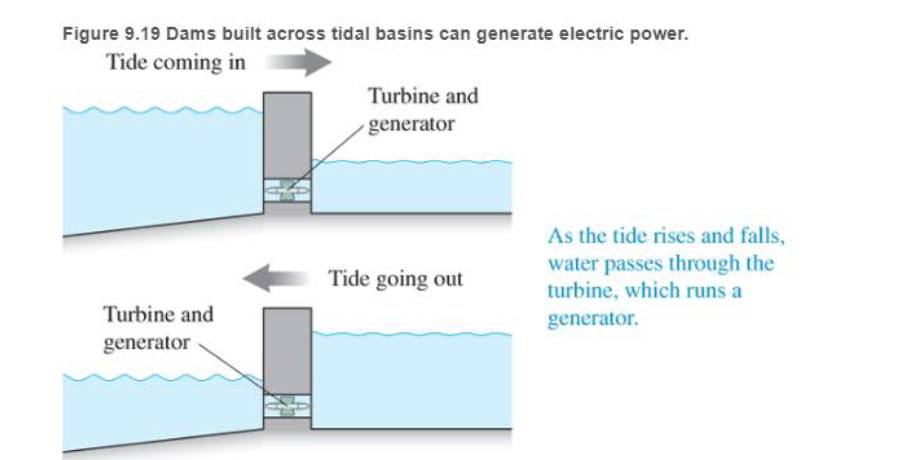
Concept explainers
Tidal energy Tides are now used so gene-ate electric power in two ways. In the first, huge dams can be built. across the mouth of a river where it exits to the ocean. As the ocean tide moves in and out of this tidal bas in or estuary, the water flows through tunnels in the dam (see Figure 9.19). This flowing water turns turbines in the tunnels that run electric generators. Unfortunately, this technique works best with large increases in tides—a 5-m difference between high and low tide Such differences are found at only a small number of places Currently, France is the only country that successfully uses this power source A tidal basin plant in France, the Rance. Tidal Power Station. makes 240 megawatts of power—enough energy to power 240,000 homes. Damming tidal basins can have negative environmental effects because of reduced tidal flow and silt buildup. Another disadvantage is that they can only generate electricity when the tide is flowing in or out, for about 10 hours each day.

A second method for collecting energy from the tidal flow (as well as all water flow) is to place turbines directly in the water—like windmills in moving water instead of in moving air. These water turbines have the advantages that they are much cheaper to build, they do not have the environmental problems of a tidal basin, and there are many more suitable sites for such water flow energy farms. Also the energy density of flowing water is about 800 times the energy density of dry air flow. Verdant Power is developing turbine prototypes in the East River near New York City and in the Saint Lawrence Seaway in Canada, and they are looking at other sites in the Puget Sound and all over the world. The worldwide potential tor hydroelectric power is about
Suppose a tidal basin is 5m above the ocean a: low tide and that the area o' the basin is
Want to see the full answer?
Check out a sample textbook solution
Chapter 9 Solutions
College Physics
Additional Science Textbook Solutions
Campbell Essential Biology (7th Edition)
Applications and Investigations in Earth Science (9th Edition)
Chemistry: An Introduction to General, Organic, and Biological Chemistry (13th Edition)
Microbiology: An Introduction
Cosmic Perspective Fundamentals
Introductory Chemistry (6th Edition)
- What is the resistance (in (2) of a 27.5 m long piece of 17 gauge copper wire having a 1.150 mm diameter? 0.445 ΧΩarrow_forwardFind the ratio of the diameter of silver to iron wire, if they have the same resistance per unit length (as they might in household wiring). d. Ag dFe = 2.47 ×arrow_forwardFind the ratio of the diameter of silver to iron wire, if they have the same resistance per unit length (as they might in household wiring). d Ag = 2.51 dFe ×arrow_forward
- Show that the units 1 v2/Q = 1 W, as implied by the equation P = V²/R. Starting with the equation P = V²/R, we can get an expression for a watt in terms of voltage and resistance. The units for voltage, V, are equivalent to [? v2 v2 A, are equivalent to J/C ✓ X . Therefore, 1 = 1 = 1 A V1 J/s Ω V-A X = 1 W. . The units for resistance, Q, are equivalent to ? The units for current,arrow_forwardPlease solve and answer the question correctly please. Thank you!!arrow_forwardPlease solve and answer the question correctly please. Thank you!!arrow_forward
 Physics for Scientists and Engineers: Foundations...PhysicsISBN:9781133939146Author:Katz, Debora M.Publisher:Cengage Learning
Physics for Scientists and Engineers: Foundations...PhysicsISBN:9781133939146Author:Katz, Debora M.Publisher:Cengage Learning College PhysicsPhysicsISBN:9781285737027Author:Raymond A. Serway, Chris VuillePublisher:Cengage Learning
College PhysicsPhysicsISBN:9781285737027Author:Raymond A. Serway, Chris VuillePublisher:Cengage Learning
 Principles of Physics: A Calculus-Based TextPhysicsISBN:9781133104261Author:Raymond A. Serway, John W. JewettPublisher:Cengage Learning
Principles of Physics: A Calculus-Based TextPhysicsISBN:9781133104261Author:Raymond A. Serway, John W. JewettPublisher:Cengage Learning Physics for Scientists and Engineers with Modern ...PhysicsISBN:9781337553292Author:Raymond A. Serway, John W. JewettPublisher:Cengage Learning
Physics for Scientists and Engineers with Modern ...PhysicsISBN:9781337553292Author:Raymond A. Serway, John W. JewettPublisher:Cengage Learning Physics for Scientists and EngineersPhysicsISBN:9781337553278Author:Raymond A. Serway, John W. JewettPublisher:Cengage Learning
Physics for Scientists and EngineersPhysicsISBN:9781337553278Author:Raymond A. Serway, John W. JewettPublisher:Cengage Learning





